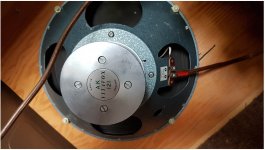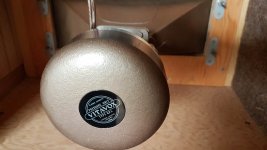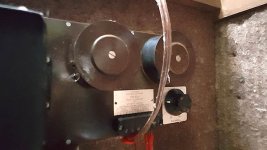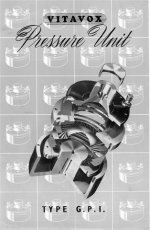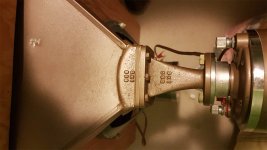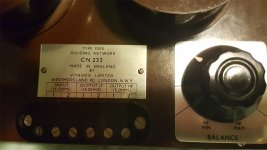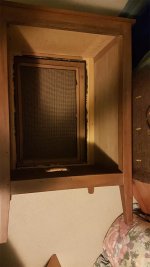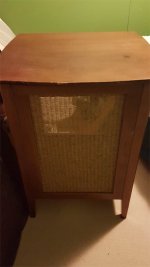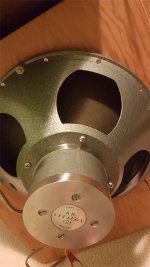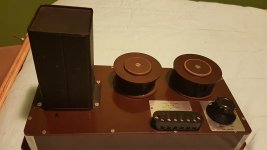I obtained two large cabinet, floor speakers years ago, and just now, got around to taking the backs off. Can anyone offer any info on this driver and horn unit? I will post photos. The crossover photo is poor though. Bad lighting. Will try again later to get a better pic of it.
Anything details would be great.
Anything details would be great.
Attachments
Lucky you - how about a picture of the cabinets?
Here's some information about Vitavox:
Vitavox Hifi - Vitavox continues to build on this illustrious history hand crafting components to power some of the world's finest loudspeaker systems
Here's some information about Vitavox:
Vitavox Hifi - Vitavox continues to build on this illustrious history hand crafting components to power some of the world's finest loudspeaker systems
Attachments
SPECIFICATIONS AK121
Catalogue number CN 243 Voice coil diameter 1,780 inches Colour code Green Magnet 3 1/4 pounds Bass Resonnance 35/40 c/s Total effect flux 160.000 Maxwells Impedance 15 Ohms Flux density 14000 Gauss Nominal response 30-5000 C:s Cone diameter 12 inches Power rating ( English) 10 Watts Piston diameter 9 1/2 inches Construction Dust-excluding Finish Satin chrome and silver grey hammertone enamel Replacement cone assembly CN247 Net Weight 13 1/2 pounds ( 6 Kilos)
Catalogue number CN 243 Voice coil diameter 1,780 inches Colour code Green Magnet 3 1/4 pounds Bass Resonnance 35/40 c/s Total effect flux 160.000 Maxwells Impedance 15 Ohms Flux density 14000 Gauss Nominal response 30-5000 C:s Cone diameter 12 inches Power rating ( English) 10 Watts Piston diameter 9 1/2 inches Construction Dust-excluding Finish Satin chrome and silver grey hammertone enamel Replacement cone assembly CN247 Net Weight 13 1/2 pounds ( 6 Kilos)
SPECIFICATIONS TYPE G.P.1.
https://www.google.com/url?sa=t&rct...php?aid=1266&usg=AOvVaw3aOJLPdjjyyWO24uIDHPds
https://www.google.com/url?sa=t&rct...php?aid=1266&usg=AOvVaw3aOJLPdjjyyWO24uIDHPds
More info, but be forewarned that if you do any posting that if he's not on his meds [or so I've been told] he can be incredibly abusive. That said, he's really knowledgeable/experienced WRT horn design: GoodSoundClub - Romy the Cat's Audio Site - Vitavox’s S2 Survival Guide.
GM
GM
tomtt No, no tube amp. Why? Would these have been made for a tube amp? If so, then I assume I won't get the quality out that is there.
Also, everyone, ...warm thanks for the info you offered. I will post better pics now that I have the unit apart. Can't believe the condition of this stuff. The Balance rheostat still has that rubbery feel to it.
Also, everyone, ...warm thanks for the info you offered. I will post better pics now that I have the unit apart. Can't believe the condition of this stuff. The Balance rheostat still has that rubbery feel to it.
Thanks for the photos. The drivers are in beautiful cosmetic condition and consequently of potential value to collectors/enthusiasts.
The loudspeakers are likely to have high sensitivity making them suitable for use with a low power valve amplifier, as would have been the case back in the day.
That, however, does not exclude their use with solid state amplification.
The loudpeakers should work without the need for major renovation - have you given them a twirl yet?
The loudspeakers are likely to have high sensitivity making them suitable for use with a low power valve amplifier, as would have been the case back in the day.
That, however, does not exclude their use with solid state amplification.
The loudpeakers should work without the need for major renovation - have you given them a twirl yet?
Last edited:
Nada! Zip! a groove down one side where they joined it, and a small bulge on the top lip, again, where the join is. I need to find the right screwdriver to remove the bottom of the crossover box. The capacitor box seems to be connected with bolts. If the capacitors are done, will it be impossible to replace them? Will I have to sell my house?
There should be ample room within the base of the dividing network to fit a much smaller, modern capacitor of the same value.
The original capacitor should be disconnected electrically but left in place physically. The replacement capacitor will be out of sight and the vintage look of the dividing network will be retained.
Depending on the capacitance value in microfarads, a replacement should not be too expensive.
The original capacitor should be disconnected electrically but left in place physically. The replacement capacitor will be out of sight and the vintage look of the dividing network will be retained.
Depending on the capacitance value in microfarads, a replacement should not be too expensive.
Last edited:
The original cap may be good, but vintage oil caps can drift in value and show an increase in resistance (ESR) which can result in a dull tweeter.
If you do not have the facility to test the cap for capacitance, ESR and leakage, then the safest option is to substitute a modern polypropylene equivalent.
But we will have to know (or be able to work out) what the original capacitance in microfarads (uF) was.
If you do not have the facility to test the cap for capacitance, ESR and leakage, then the safest option is to substitute a modern polypropylene equivalent.
But we will have to know (or be able to work out) what the original capacitance in microfarads (uF) was.
- Status
- This old topic is closed. If you want to reopen this topic, contact a moderator using the "Report Post" button.
- Home
- Loudspeakers
- Multi-Way
- Mystery speakers!
